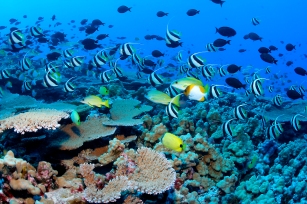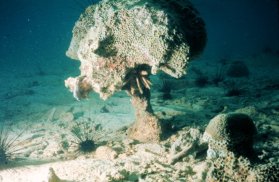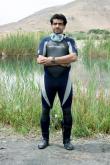استاد عزیزم
جناب آقای علی اکبر حاجی محمدی
اینجانب سرپرست و مسئول تیم غواصی پاسداران خلیج فارس حامی و دوستدار محیط زیست
خلیج همیشه فارس
کلیه فعالیتهای غواصی از جمله کار اکتشاف غواصی جزایر ایرانی خلیج فارس را
مدیون استاد عزیزم جنای استاد حاجی محمدی میدانم
Reef
CANBERRA (Reuters) -– Australia"s Great Barrier Reef, the world"s largest living organism, is under grave threat from climate warming and coastal development, and its prospects of survival are “poor,” a major new report found on Wednesday.
While the World Heritage-protected site, which sprawls for more than 345,000 square km (133,000 sq miles) off Australia"s east coast, is in a better position than most other reefs globally, the risk of its destruction was mounting.
“Even with the recent management initiatives to improve resilience, the overall outlook for the Great Barrier Reef is poor and catastrophic damage to the ecosystem may not be averted,” a government reef management body said in the report.
The five-yearly reef outlook report, aimed at benchmarking the health of the reef, found climate change, declining water quality from coastal runoff, development and illegal fishing were the biggest dangers to the reef.
The study echoed findings by scientists belonging to the UN Intergovernmental Panel on Climate Change that the Great Barrier Reef could be “functionally extinct” within decades, with deadly coral bleaching likely to be an annual occurrence by 2030.
The reef was one of the most diverse and remarkable ecosystems in the world, and populations of almost all marine species were still large, the government"s Great Barrier Reef Marine Park Authority said in the report.
But some ecologically important species, such as dugongs, marine turtles, seabirds, black teatfish and some sharks had declined significantly, while coral diseases and pest outbreaks like crown-of-thorns starfish appeared to be increasing and becoming more serious.
A separate report by the Australian Institute of Marine Science, also released on Wednesday, found ocean temperatures on northern parts of the reef had been a degree above average through winter, pointing to a bad year for coral bleaching. “We know that a failure to act on dangerous climate change puts at risk significant places like the Great Barrier Reef and this report confirms the scale of the challenge ahead,” Australia"s Environment Minister Peter Garrett said.
Bleaching occurs when the tiny plant-like coral organisms die, often because of higher temperatures, and leave behind only a white limestone reef skeleton.
Garrett and Queensland state Premier Anna Bligh unveiled a plan to improve water quality on the reef.
It followed a report last year which found agricultural run-off was killing the reef, with some sections already irreversibly damaged.
The plan aimed to halve the runoff of harmful nutrients and pesticides by 2013 and ensure 80 percent of agricultural enterprises and 50 percent of grazing operations were taking steps to reduce runoff.
The World Wide Fund for Nature (WWF) said the report added urgency to a debate in Australia"s parliament on laws to curb carbon emissions, rejected last month by the upper house Senate and due for a second vote in mid-November.
“We cannot sit back and let the world"s largest and most iconic reef system die on our watch,” said WWF reef campaigner Nick Heath.
Corals are under severe threat from climate change as higher temperatures cause them to lose the algae that provide them with energy. But salvation may come in the form of a newly discovered ability of corals to swap their algal partners with strains that can take the heat.
Among all of the world’s animals, the two which have built the largest settlements could not be more different. The champions, humans, are intelligent and mobile, rapidly adapting to new conditions with technology and ever-changing strategies. In contrast, the runners-up, corals, seem unchanging and immobile, spending their lives ensconced in their impressive but stationary reefs. But it now seems that corals may have to adapt quickly in the face of looming extinction, ironically, brought about by humans.
 Corals are hugely successful animals. Their reefs have endured across millions of years and today, they cover an area of 280,000 square kilometres, larger than the entire United Kingdom. Their success depends on a partnership with a group of algae called zooxanthellae. Over a million of these lodgers can live in a single cubic centimetre of coral, and they provide their landlords with both colour and energy through photosynthesis.
Corals are hugely successful animals. Their reefs have endured across millions of years and today, they cover an area of 280,000 square kilometres, larger than the entire United Kingdom. Their success depends on a partnership with a group of algae called zooxanthellae. Over a million of these lodgers can live in a single cubic centimetre of coral, and they provide their landlords with both colour and energy through photosynthesis.
Despite their benefits, the algae are expensive to maintain. During periods of environmental stress, the corals eject them to make ends meet, losing their colour in the process. These ‘bleached’ corals (below) are free to regain their partners at easier times, but if conditions don’t improve, they die.

This is the doom that they now face as global warming threatens to send oceanic temperatures soaring to record levels. The existence of the corals and the biological riches they support is under severe threat. But new research from by Ray Berkelmans and colleagues at the Australian Institute of Marine Science shows that some corals may be able to buy themselves some extra time by swapping their algal partners.
There are 8 different lineages of zooxanthellae (labelled A to H) and it is becoming increasingly clear that how a coral reacts to its environment depends on which of these groups it harbours. In particular, corals with group D algae seem to be particularly good at dealing with high temperatures, and this might prove to be their salvation.
Berkelmans tested this idea by transplanting 22 colonies of the stony coral (Acropora millipora) from a cool inshore reef on the eastern coast of Australia, to a warmer bay about 400 miles away. The colonies contained group C algae, and within half a year, they had all bleached and seven had died. But a few months later, about half of them had recovered and regained their colour. Every single survivor had replaced their partners with those from group D.
Further experiments revealed that the corals’ ability to tolerate temperature was based almost entirely on their choice of partners, with their own biochemistry had no detectable effect. In this partnership, the algae proved to be the weakest link. The key difference between the various groups lies in the membranes of their chloroplasts – their in-house photosynthesis factories. Those that can take the heat have membranes that are stable across a larger range of temperatures.
It isn’t clear from this study alone whether the ability to evict less hardy tenants is widespread among coral species, or even among other populations of stony coral. Even if it is, it may not be enough. Berkelmans found that corals that made the swap could tolerate temperatures about 1-1.5°C higher. With the temperatures of the world’s oceans set to increase beyond that, the corals are living on borrowed time.
We can only hope that this newly discovered ability of corals to rapidly adapt to environmental change gives us enough time to curb carbon emissions and halt climate change
C.M.A.S

CMAS (World Underwater Federation) is the organization of the divers. The way goes from the diver over the association and the national dipping sport federation to the world union. The CMAS is not excluding a certification agency. The CMAS was created on 15 January 1959 of 15 countries in Monaco under the patronage of Commander Jacques Yves Cousteau. Since 1994 is the seat in Rome, 94 countries belongs to the federation, and it is Mitlied into the IOC, ind the UNESCO, into the IUCN, into the GAIFS and into the World Games Organization.
The Executive office consists of the three committees sport, technique and science as well as the independent commissions medicine and right .
The three columns of the CMAS:
-
Fin-swim as olympic discipline
-
International price for the navy environment
-
World-wide formation standards for the dipping sport recognized
CMAS* and CMAS** Certification Courses
Our cooperative Nautilus became a federation of the World Underwater Federation (C.M.A.S.), thus allowing our instructors and divers the distinct designation of this international certification.
Start with snorkeling, holding your breath forever. Dive a distance of 12m for the one-star and 25m for the two-star certification. Learning is more fun than with CMAS. While CMAS** students do emergency ascends, rescue and first aid.









